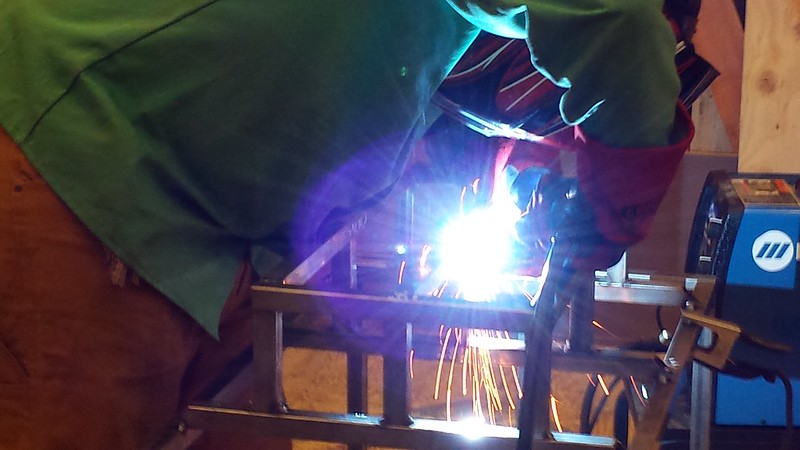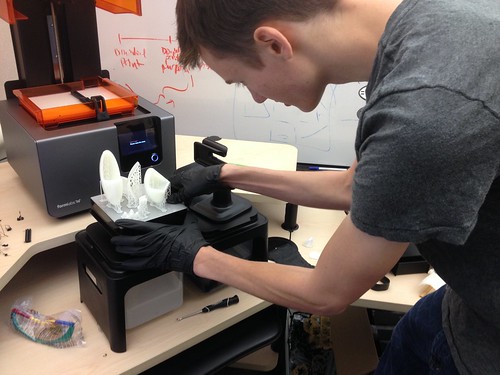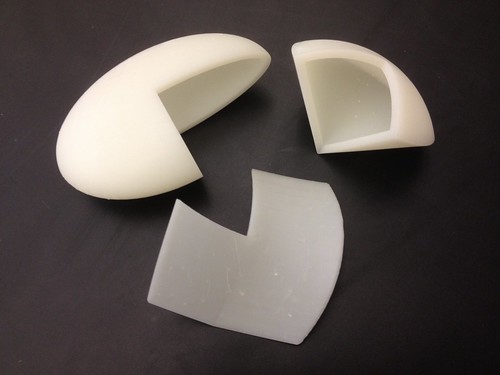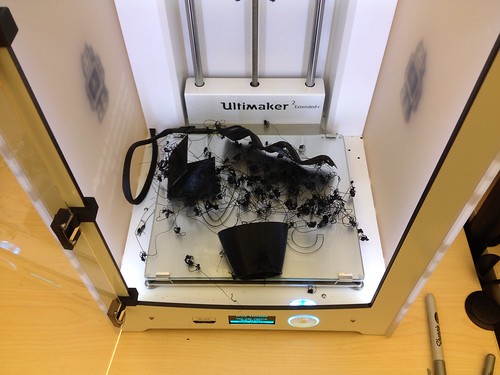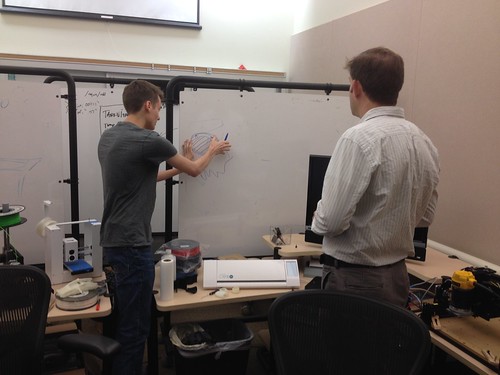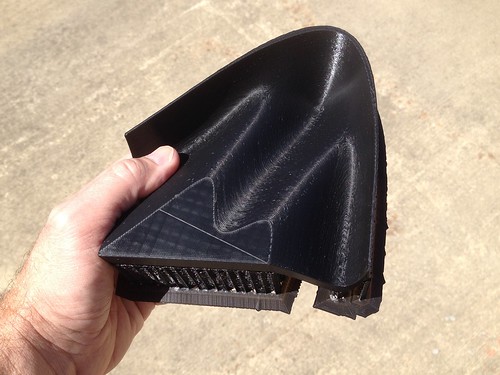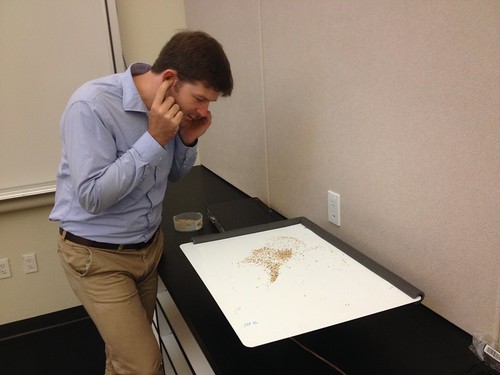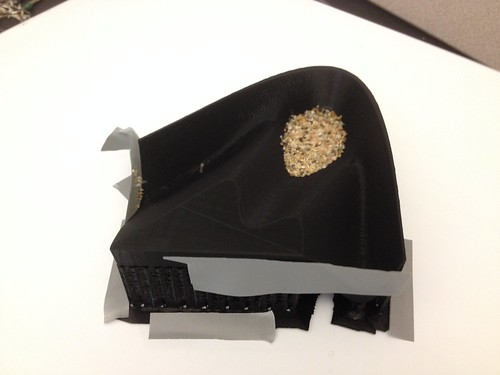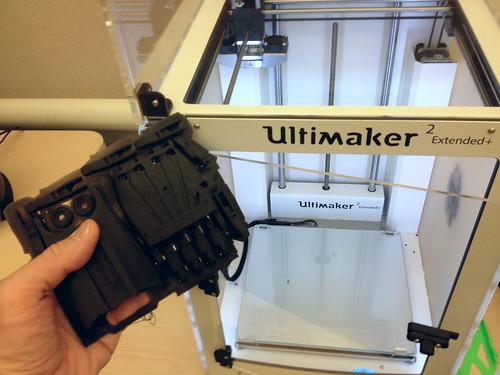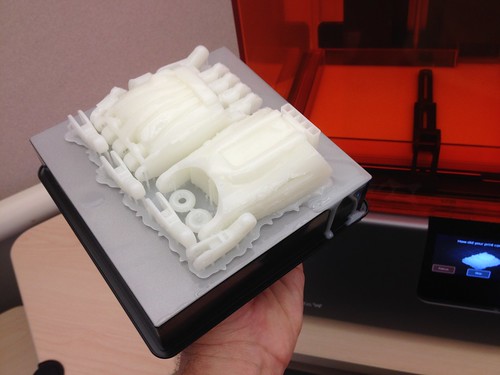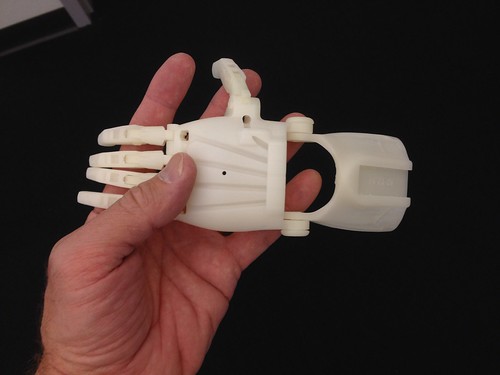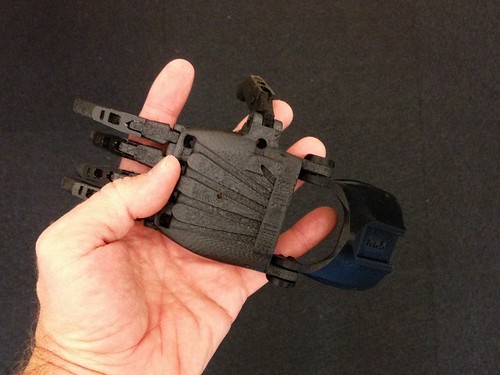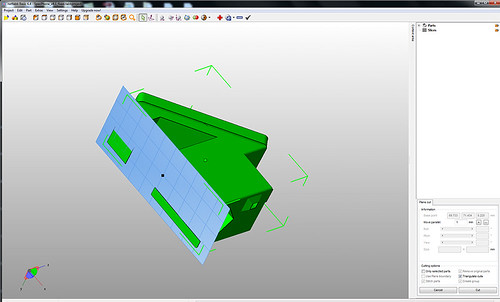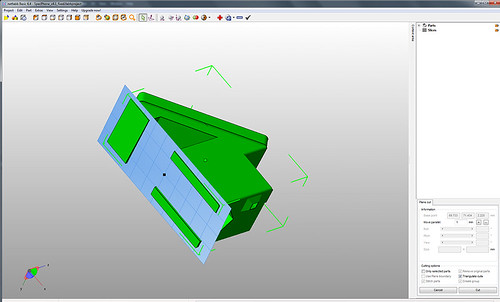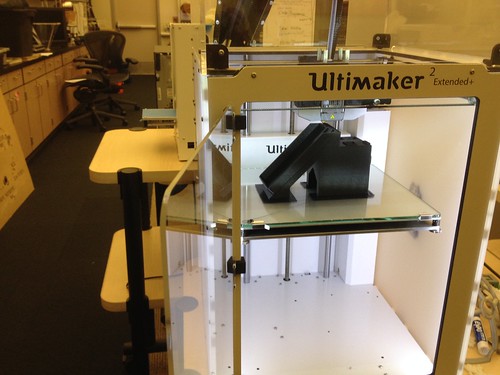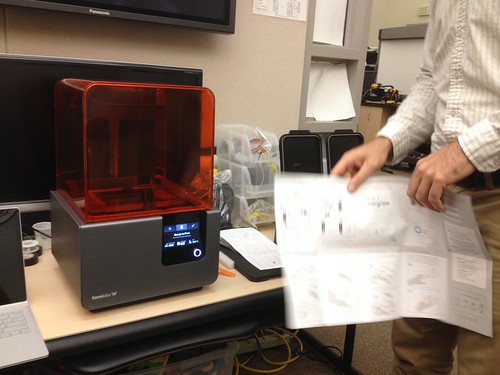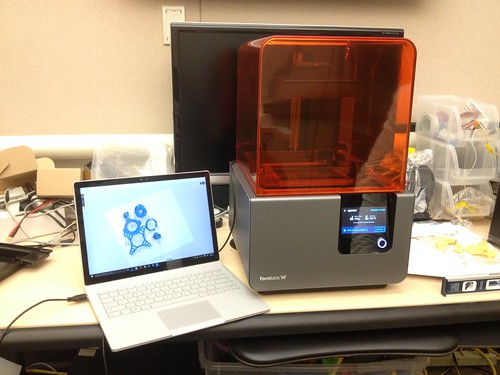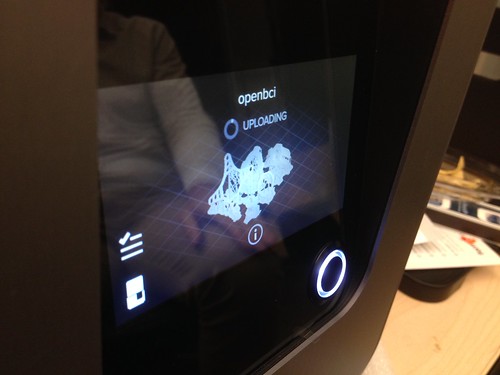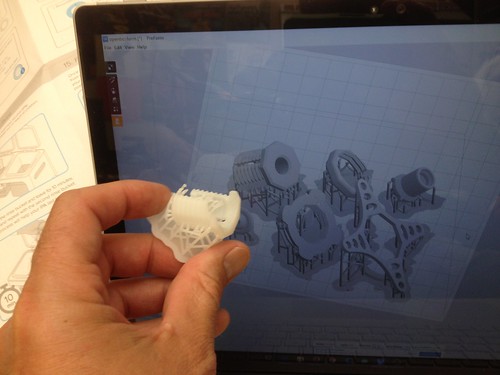After a rather lengthy pause in the project, owing mostly to institutional rhythms, Cameron Hoyt (formerly a student, now an employee of the college in the Theater Arts Department) and his crew began work on the structural skeleton of the aquaponics display.
Below is Alex Hartigan, a Folsom Lake College Engineering student preparing some Calculus III models he’s been developing in collaboration with Kevin Pipkin (Math) and that he printed on the new Form 2, which has gotten a lot of use lately, most recently with the Enabling the Future project.
Alex and I connected last semester, and finally got the chance to work together on this Math project. Alex has a lot of skills in 3D design and printing, as well as experience on the Form 1, and through the process of preparing the Calc models, he taught me a whole lot about the finer points of printing on the Form 2, including various layout tips, and the manual editing of supports.
The Form 2 models came out great:
The Ultimaker 2 ones, not so much, though the failure at least resulted in some interesting artifacts:
Best of all, Max Mahoney (Chemistry) dropped by, and we recruited Alex to work on the chemistry project we prototyped the other day. One of my favorite parts of working with students is learning from them, and I hope to learn a lot from Alex before he heads off to Sac State next fall.
Working on a new prototype, combining the models from 3D Printed Potential and Free Energy Surfaces for Teaching Fundamental Concepts in Physical Chemistry (Kaliakin, Zaari, and Varganov) and something like this:
Max Mahoney (Chemistry) printed one of the models from the aforementioned paper, and we got to discussing how we might fill it with sand and inject some energy in the system to motivate the sand to shift around to demonstrate concepts of chemical reaction kinetics and dynamics.
I found a Sonic Ghost VX-GH72 Electro-Mechanical Audio Transducer in the workshop. I purchased it some years ago hoping to replicate a sweet project I once saw at Maker Faire, developed by Sasha Leitman and involving 50 gallon metal drums with contact mics attached, with the drums acting as…well…drums, but also acting as speakers. Anyhow, we hooked the transducer up to a piece of metal and threw some sand from the aquaponics project on there, and played around with different frequencies.
We ended up breaking the transducer, and substituting a speaker, upon which we place the metal sign, with the model taped to the top.
We were able to get the sand to bounce out of the lowest spot and into one of the higher ones, so the rough prototype is showing promise…
The recent EpiPen controversy led to lots of good conversations this week with various faculty about “medical making,” either as a new class in our upcoming MAKR certificate, a semester-long sort of focus, similar to things like One Book, or as some focus within the larger construct of Making + Doing, which is an idea we’ve been kicking around as a way to intertwine making and service learning. One of the projects that emerged from those conversation is Enabling the Future, an “amazing group of individuals from all over the world who are using their 3D printers to create free 3D printed hands and arms for those in need of an upper limb assistive device.”
Jennifer Kraemer (ECE) is interested in working such a project into the Making in ECE course she’s developing, so we decided to print up one of the hand systems, specifically the Raptor Reloaded. We set up a job on both the Ultimaker 2 Extended+ and the Form 2, so as to compare time and print quality.
11ish hours later for the Ultimaker…
8ish hours later for the Form 2…
Here’s the initial build of the Form 2 version. The Form 2 resin creates a really nice finished product that takes well to fine tuning with a file.
Here’s the initial build of the Ultimaker version.
I still need to get the screws and wire for the “tendons” to finish them up, but the initial results are promising.
Max Mahoney (Chemistry) is working on printing SpecPhone, a 3D-printed smartphone spectrophotometer develop by Dr. Adam W. Smith’s lab at the University of Akron. From the developer:
The SpecPhone is a 3D-Printed smartphone spectrophotometer for research and education. The device can make analytically accurate measurements of concentration and can be used for teaching analytical chemistry and DIY science projects.
After some sketchy results and strange print decisions by the Ultimaker, it seems that the model doesn’t quite sit flat. That is, the legs don’t seem to be the same height. Using Netfabb Basic, I dropped in a Z plane to visualize:
Taking that plane up, it seems that it’s not just the bottom of the model, but that the skew continues all the way to the top:
With support structure enabled in Cura, we were able to print it after a few botched attempts, so it’s not a deal-killer, just a bit awkward. Now we just need to find an iPhone 5s…
Technology and the Future of Education ~or~ Robots Will Save/Enslave Us All (08.19.16)
FLC Online Educators (08.18.16)
FLC DE Vision Document – https://docs.google.com/document/d/1d_pZRsavqhM82st5_c3nfjEE8d9dpn-Yi7-cokbke_w/edit?usp=sharing
Links and presentation materials for my reMAKE presentation on 08.04.16
Making Across the Curriculum Presentation Slides
https://docs.google.com/presentation/d/1cfvyZ2MD5iVAAL2fp8a6LYEJ-SFTppNqN48ex93uq6I/edit?usp=sharing
INNOVATIONMAKER 3
http://extranet.cccco.edu/Divisions/WorkforceandEconDev/WEDDRFAs/RFAInnovationmaker.aspx
The Tinkering Studio Learning and Facilitation Frameworks
http://tinkering.exploratorium.edu/learning-and-facilitation-frameworks
Sierra College Center for Applied Competitive Technologies
http://sierracollegetraining.com/
Sacramento Hacker Lab
http://hackerlab.org/
DoLookDown.org
http://dolookdown.org
Free Universal Construction Kit
http://fffff.at/free-universal-construction-kit/
OpenBCI
http://openbci.com
Learn to Solder Kits/Rocket Department
http://learntosolderkit.com/about/
LibraryLyna
http://www.librarylyna.com/
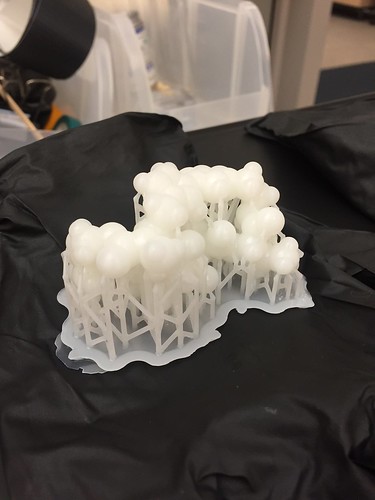
Max made his molecule again, this time on the Form 2.
Finally had the chance to set up the new Form 2 and give it a go. Met Max Mahoney (Chemistry) in the Innovation Center and we walked through the quick start guide.
Once we got our head around the setup and leveling, we set up a print job. Originally, we planned to print Max’s molecule, but decided instead to try a set of some small parts from the OpenBCI headset. The software complained about some problems with the STL files, and then offered to automatically fix them, so we allowed it to.
The Form 2 has an interesting way of laying out objects, placing them all at a jaunty angle and adding a bunch of lattice-like scaffolding for support. There was a slight hiccup with the firmware update, but that was solved after a message to the Form 2 support folks. The solution was to download the new firmware and then select it, rather than letting the software automatically do that. Suggestion to FormLabs: Put a link to download the latest firmware on your support site, which would save calls/emails to support personnel.
Anyhow, the printer has a nice touchscreen interface, and navigating various functions is generally intuitive, though the network information – the printer can connect via Wi-Fi (admittedly in Beta) and Ethernet – is spotty and could use some work. Specifically, there don’t seem to be any diagnostics or deeper information about network connectivity, or a way really to know that the machine is able to get out to the Internet. In our college network environment, those kinds of diagnostic tools are crucial, as it is essentially a nightmare to get any device connected to the network. After connecting an Ethernet cable, the only information available was that the Form 2 received an IP lease. On the Wi-Fi side, I was not able to manually enter the name of the one hidden network available at the college that uses authentication simple enough to allow connection of strange devices. Finally, there doesn’t seem to be a way to trigger the leveling process except to wait for the machine to squawk about being out of level. It would be nice to be able to just trigger that process from the menu system. I hope those issues can be addressed at some point, but we were able to work around them and get the first print job uploaded.
The printer ran the job, taking about 2.5 hours, and I streamed it live via the OpenBroadcaster setup. Post processing takes some getting used to, and involves nitrile gloves and bathing the parts in isopropyl alcohol at the finishing station. The print was a mixed success – some parts printed fine, and others were less than complete. My suspicion as that the “automatically fix the files?” part of the process didn’t actually work properly.
I do quite like that the printer sent me an email when the job was completed. My plan is to fix the files prior to importing them into PreForm, and then run the job again to try and get a better result. All in all, not bad for a first go, and we learned a lot about the process. Always be prototyping!
Deep within these boxes…
The new Form 2 3D printer!
Planning on having a regional unveiling, as folks from Rocket Department and Sierra College and Hacker Lab and some of our sister colleges are interested in checking it out. Sharing is caring! First print I think will be parts for the OpenBCI.

